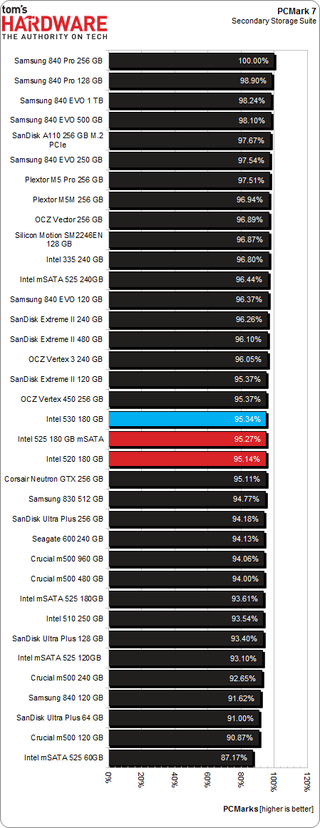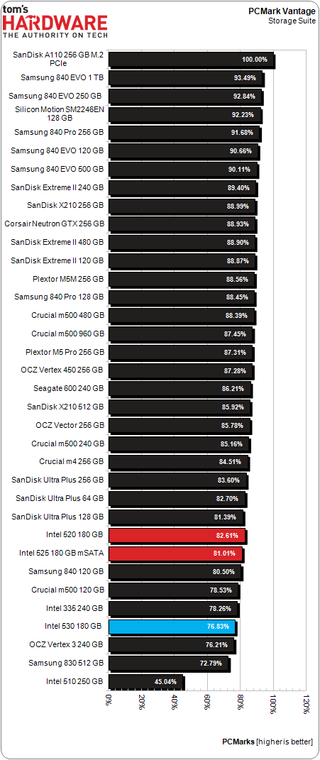Intel SSD 530 Review: A Revised Controller And 20 nm Flash
Intel recently lifted the veil on a replacement for its SSD 520, not surprisingly called the SSD 530. It partners new SandForce silicon with IMFT's 20 nm flash for better power consumption and a more modest price tag. Does the evolution pay off?
Results: PCMark Vantage And PCMark 7
Futuremark's PCMark 7: Secondary Storage Suite
PCMark 7 uses the same trace-based technology as our Storage Bench v1.0 for its storage suite testing. It employs a geometric mean scoring system to generate a composite, so we end up with PCMarks instead of a megabytes per second. One-thousand points separate the top and bottom, but that encompasses a far larger difference than the score alone indicates.
This test is a big improvement over the older PCMark Vantage, at least for SSD benchmarking. The storage suite is comprised of several small traces. At the end, the geometric mean of those scores is scaled with a number representing the test system's speed. The scores generated are much different from PCMark Vantage, and many manufacturers are predisposed to dislike it for that reason. It's hard to figure out how PCMark 7 "works" because it uses a sliding scale to generate scores. Still, it represents one of the best canned benchmarks for storage, and if nothing else, it helps reinforce the idea that the differences in modern SSD performance don't necessarily amount to a better user experience in average consumer workloads.

In a reversal of the previous page, Intel's SSD 530 outpaces the 520 and 525, though the margin is as slim as can be.
We're including a bit more information in this review. Not only do you get the raw scores in PCMarks, but we also calculate percentages relative to the fastest finisher (in this case, Samsung's 840 Pro 256 GB). The SSD 530 achieves 95.34% of the first-place drive's score, while the SSD 520 and 525 earn 95.27% and 95.14%, respectively. Those are solid outcomes across the board.
Futuremark's PCMark Vantage: Hard Drive Suite
PCMark's Vantage isn't the paragon of SSD testing, mainly because it's old and wasn't designed for the massive performance solid-state technology enables. Intended to exploit the new features in Windows Vista, Vantage was certainly at the forefront of consumer storage benching at the time. Vantage works by taking the geometric mean of composite storage scores and then scaling them a lot like PCMark 7 does. But in Vantage's case, this scaling is achieved by arbitrarily multiplying the geometric sub-score mean by 214.65. That scaling factor is supposed to represent an average test system of the day (a system that's now close to a decade behind the times). PCMark 7 improves on this by creating a unique system-dependent scaling factor and newer trace technology.
Stay on the Cutting Edge
Join the experts who read Tom's Hardware for the inside track on enthusiast PC tech news — and have for over 25 years. We'll send breaking news and in-depth reviews of CPUs, GPUs, AI, maker hardware and more straight to your inbox.
Why bother including this metric, then? A lot of folks prefer Vantage in spite of or because of the cartoonish scores and widespread adoption. That, and the fact that most every manufacturer uses the aged benchmark in box specs and reviewer-specific guidelines. In fairness, Vantage's Hard Drive suite wasn't designed with SSDs in mind, and is actually quite good as pointing out which 5400 RPM mechanical disk might be preferable.

Intel's SSD 510 at 250 GB manages just 45.04% of the SanDisk A110's finish. That makes the trio of more modern 180 GB Intel drives look brilliant by comparison, though the SSD 530 does trail the SSD 520 and 525, based on SandForce's earlier-revision controller.
Current page: Results: PCMark Vantage And PCMark 7
Prev Page Results: Tom's Hardware Storage Bench, Continued Next Page Results: File Copy Performance With Robocopy-
jimmysmitty I went with a 520 for the fact that Intel has some of the best reliability along with Samsung.Reply
As well we wont see much of a difference in performance until SATA Express (8Gb/16Gb) and even then we might not notice it.
The main benefit is lowering the price. If it sells for $170 that's a bit lower than $1/GB which is good since Intel is always a bit pricier than others. -
cryan Reply11835302 said:I went with a 520 for the fact that Intel has some of the best reliability along with Samsung.
As well we wont see much of a difference in performance until SATA Express (8Gb/16Gb) and even then we might not notice it.
The main benefit is lowering the price. If it sells for $170 that's a bit lower than $1/GB which is good since Intel is always a bit pricier than others.
I can't, in good conscience, recommend anyone actually buy the 180 GB 530 -- not when the retail boxed 240 GB is only $198.
Jay Crest (the 335) is a few bucks less, and its 240 GB edition is hovering near $180. Nice, but for just $20 more, grab the 530 240 GB box and call it a day... if for no other reason than the extra warranty coverage.
Regards,
Christopher Ryan
-
RealBeast I got a 480GB 520 a year ago on a great sale with the typical Intel rebate. Great drive. I'm hoping to see a nice rebate again this year as I need a number of drives.Reply -
diazalon Where i am the 840 pro is cheaper so i think i will just get that, seems to perform pretty well tooReply -
ssdpro The compressed vs incompressible data issue is still a problem for me with LSI/SandForce controllers. I need consistent data transfer and get that with my 840 Pro and Vector drives. With so many options I boil it down to 3 considerations: 1) Is data transfer consistent across data types and as fast as possible, 2) are there reasonable tools available from the manufacturer for examining drive condition, 3) how is the warranty and support in the event of the failure. The Intel 520/530 offering fails point 1 where Samsung 840 Pro and OCZ Vector excel. Intel, Samsung, and OCZ pass point 2. OCZ wins point 3 easily. They have active support forums and mostly reasonable support staff. Intel has decent process, OCZ has decent process. Samsung has horrid and lengthy support procedures. If you visit Samsung.com to initiate a support request I bet you can't even find your Evo or Pro on the drop down menu you MUST use. You have to call and wait on hold endlessly.Reply -
vertexx Thanks for the informative article - would have liked to see a couple different capacities tested.Reply
If you look at the number of models and form-factors available for the 530, I'd say this product line is primarily about one thing: Distribution.
The price points for the 240-256GB capacity drives have come down enough where they're probably ready for the mainstream. You see this with Samsung's aggressive (and cheesy) marketing of it's EVO line to the mass consumer market, and this is Intel's attempt to achieve maximum penetration into that market.
About two months ago, I refreshed my 2-year-old primary work laptop with the Intel 335 240GB. It was on a special at Newegg for $50 off at $170. Now that same drive lists for $180. For a work PC, I was waiting for SSD affordability in the 240-256GB range before pulling the trigger, as anything less would lead to too much hassle moving files around between drives. So, I upgraded from a single 500GB HDD that was getting slower by the day to a 240GB SSD for my primary and a new 750GB secondary HDD running in a caddy in the ODD bay. With this upgrade, I believe I'm set for the next couple of years with this laptop, given the lower pace of development for core CPU tech.
Overall I'd say that the 530 performance numbers in this article are disappointing, although low power consumption certainly is valuable for the laptop market. Still, I think the market expects performance improvement along with power efficiency improvement, even though reality is you probably wouldn't notice the difference in everyday use.
It would have been good to see the performance numbers for the 240GB drive, as that really is the minimum point where you could reasonably get away with running a SSD as your sole system drive. With the prices coming down at that capacity, there certainly is a point in marketing SSD affordability in the mainstream segment.
The other main selling point for me was reliability. Samsung leads the pack here with Intel not far behind. I passed over the Sandisk Ultra Plus 256GB recommended in Tom's "Best SSD's for the $$" due to a high percentage of 1-star ratings on Newegg and only 2-year warranty. It came down to the 335 and the 840 Evo, with the Evo having slightly better performance and the 335 at that point being about $30 cheaper with the Newegg Promo. I went with the lower price and the rest is history.
For those contemplating upgrading to a consumer grade SSD, don't sweat the minor performance differences. Go with a good brand and a line with good reliability ratings. Do the hard work of re-installing a fresh copy of Windows (instead of using a migration utility), and your system will be flying. I couldn't be happier with this upgrade.
-
npyrhone I think this is the least exciting SSD release this year. I really challenge you to find a major SSD release this year that showed less. 530 is relatively expensive and on the slow side. It excels in nothing.Reply
Intel's post x-25 SSDs' only claim for fame is "reliability" which is nothing but a mantra. Intel's SSD are no more or less reliable than any other manufacturer's. They do give a five-year warranty, true, but it means nothing. They break down just as often as others do, and because of this, Intel pays a bit more by sending replacement drives. This is small potatoes, a minute cost to pay to be considered "more reliable" by those less informed. Especially since the warranty does not cover all the hassle and expenses that come from actually replacing the broken drive (you must stop working, start waiting, install the new drive, move all the data, etc). Of course its nice to live in the beautiful illusion that by buying an Intel SSD I am more safe from all this.
I would never buy this over a Samsung-product that is less expensive, has greater performance and equal reliability. I can't understand why this article concludes like it does. It should say: "There is nothing wrong with 530, but you can get better for cheaper, so stay away from 530." -
cryan The 530 and the newly announced 1500 Pro are both about filling out the gaps in client computing. Both are nearly identical, with wide varieties of form factors and capacity points.Reply
Regards,
Christopher Ryan
-
npyrhone Cristopher: Is there a single metric that would support the decision for anyone to fill that gap with an Intel 530 product, rather than with a Sandisk Ultra Plus product, or Samsung 830 840 (EVO) product?Reply
Most Popular

